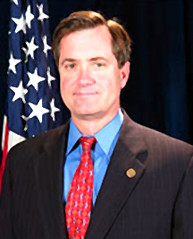"At the end of the briefing, questions were asked. I should have intervened and I didn't," said John P. "Pat" Philbin, former external affairs director for Federal Emergency Management Agency (FEMA) about his involvement in staging a fake news conference last Tuesday on the California wildfires.
The decision to stage questions with stand-ins for a FEMA news conference came after reporters were given only 15 minutes notice. While the agency also made an 800 number available for call ins, it was a listen-only arrangement. Several channels broadcasted parts of the conference live via a video feed.
Philbin will no longer take over public affairs for the Director of National Intelligence (DNI), which he had previously been offered by Mike McConnell, director of the DNI. Philbin said he understood McConnell's decision.
“It was one of the dumbest and most inappropriate things I’ve seen since being in government,” came the harshest criticism from Homeland Security chief Michael Chertoff. “I have made it unambiguously clear, in Anglo Saxon prose, that it is not to ever happen again, and there will be appropriate disciplinary action taken against those people who exhibited what I regard as extraordinary poor judgment.”
Philbin may have been the fall guy, but the entire external affairs team could have been let go. No one of them, not a single team member, seemed to comprehend that staging a fake news conference was ridiculous, unethical, and a severe breach of public trust.
Let’s star over.
“Public Relations is the art and science of analyzing trends, predicting their consequences, counseling organization leaders and implementing planned programs of action which will serve both the organization’s and the public interest.” — First World Assembly of Public Relations Associations and First World Forum of Public Relations, 1978
Nowhere in this definition is a public relations professional asked to spin, lie, cover up, or otherwise present fake and fraudulent information for their employer. What is clear, however, is that professionals are to serve both the organization’s and public interest.
Maybe I should make it as clear as I make it for public relations students: the organization you defraud the public for will survive and may even thrive over time, but any abuse of public trust or the media will stay with you for the life of your career.
In this case, FEMA will carry on, while Philbin is out of his DNI job. While I admire his sincerity in saying “at the end of day, I’m the person in charge and responsible for this,” he is not doing any favors for new public relations professionals. The truth is that every single participant was responsible — whether an intern or seasoned pro. Any one of them could have suggested they skip questions and simply make a statement.

The decision to stage questions with stand-ins for a FEMA news conference came after reporters were given only 15 minutes notice. While the agency also made an 800 number available for call ins, it was a listen-only arrangement. Several channels broadcasted parts of the conference live via a video feed.
Philbin will no longer take over public affairs for the Director of National Intelligence (DNI), which he had previously been offered by Mike McConnell, director of the DNI. Philbin said he understood McConnell's decision.
“It was one of the dumbest and most inappropriate things I’ve seen since being in government,” came the harshest criticism from Homeland Security chief Michael Chertoff. “I have made it unambiguously clear, in Anglo Saxon prose, that it is not to ever happen again, and there will be appropriate disciplinary action taken against those people who exhibited what I regard as extraordinary poor judgment.”
Philbin may have been the fall guy, but the entire external affairs team could have been let go. No one of them, not a single team member, seemed to comprehend that staging a fake news conference was ridiculous, unethical, and a severe breach of public trust.
Let’s star over.
“Public Relations is the art and science of analyzing trends, predicting their consequences, counseling organization leaders and implementing planned programs of action which will serve both the organization’s and the public interest.” — First World Assembly of Public Relations Associations and First World Forum of Public Relations, 1978
Nowhere in this definition is a public relations professional asked to spin, lie, cover up, or otherwise present fake and fraudulent information for their employer. What is clear, however, is that professionals are to serve both the organization’s and public interest.
Maybe I should make it as clear as I make it for public relations students: the organization you defraud the public for will survive and may even thrive over time, but any abuse of public trust or the media will stay with you for the life of your career.
In this case, FEMA will carry on, while Philbin is out of his DNI job. While I admire his sincerity in saying “at the end of day, I’m the person in charge and responsible for this,” he is not doing any favors for new public relations professionals. The truth is that every single participant was responsible — whether an intern or seasoned pro. Any one of them could have suggested they skip questions and simply make a statement.



























